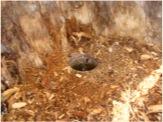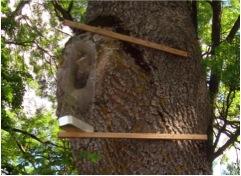Material & methods
Study sites
This study was conducted around Linköping, Östergötland, south-eastern Sweden. An area dominated by old oaks. 48 hollow trees were selected, clustered at 10 study sites (Figure 1). At each site, at least one hollow oak (Quercus robur) was examined together with one or several hollow tree species of ash (Fraxinus excelsior), norway maple (Acer platanoides) and/or small-leaved lime (Tilia cordata).

Beetle trapping
Beetles were collected using two kinds of traps – pitfall traps and window traps. The pitfall trap was a 7 cm in diameter plastic jar placed in the tree hollow with the opening level with the wood mould surface (Fig. 2). The window trap was of a 30x50 cm2 wide, vertical transparent plastic plate with a tray underneath and was placed near (within 1 m) from the entrance of the tree hollow (Fig.3).


The trays were filled to 70% with a solution of about 50% water, 50% propylene glycol, some denaturated alcohol to prevent animals from drinking the solution, and a few drops of detergent to reduce surface tension. The traps were in the trees from May to the later part of August and were emptied four times during that time.
Responsible for this page:
Director of undergraduate studies Biology
Last updated:
05/21/11
